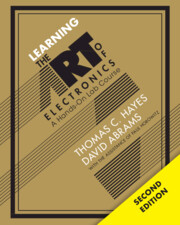Book contents
- Learning the Art of Electronics
- Learning the Art of Electronics
- Copyright page
- Dedication
- Contents
- Preface to the Second Edition
- Preface to the First Edition
- Overview, as the Course begins
- Part I Analog: Operational Amplifiers and their Applications
- Part II Analog: Discrete Transistors
- 4N Transistors I
- 4L Lab: Transistors I
- 4W Worked Examples: Transistors I
- 5N Transistors II
- 5L Lab: Transistors II
- 5S Supplementary Notes and Jargon: Transistors II
- 5W Worked Examples: Transistors II
- Part III Analog: Operational Amplifiers and their Applications
- Part IV Digital: Gates, Flip-Flops, Counters, PLD, Memory
- Part V Digital: Analog–Digital, PLL, Digital Project Lab
- Part VI Microcontrollers
- Book part
- Index
5W - Worked Examples: Transistors II
from Part II - Analog: Discrete Transistors
Published online by Cambridge University Press: 18 March 2025
- Learning the Art of Electronics
- Learning the Art of Electronics
- Copyright page
- Dedication
- Contents
- Preface to the Second Edition
- Preface to the First Edition
- Overview, as the Course begins
- Part I Analog: Operational Amplifiers and their Applications
- Part II Analog: Discrete Transistors
- 4N Transistors I
- 4L Lab: Transistors I
- 4W Worked Examples: Transistors I
- 5N Transistors II
- 5L Lab: Transistors II
- 5S Supplementary Notes and Jargon: Transistors II
- 5W Worked Examples: Transistors II
- Part III Analog: Operational Amplifiers and their Applications
- Part IV Digital: Gates, Flip-Flops, Counters, PLD, Memory
- Part V Digital: Analog–Digital, PLL, Digital Project Lab
- Part VI Microcontrollers
- Book part
- Index
Summary
How do high-gain amplifiers, see Fig. 5W.1, compare with respect to “linearity” or constancy of gain over the output swing? Explain your conclusion, briefly. Assume that each amplifier is fed by a properly-biased input.
- Type
- Chapter
- Information
- Learning the Art of ElectronicsA Hands-On Lab Course, pp. 255 - 260Publisher: Cambridge University PressPrint publication year: 2025

